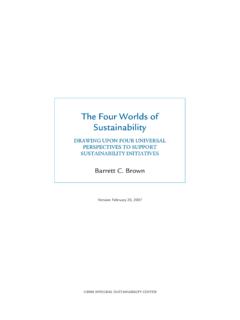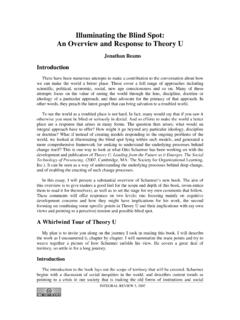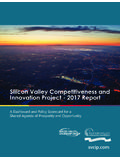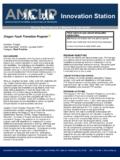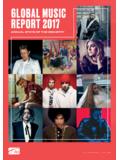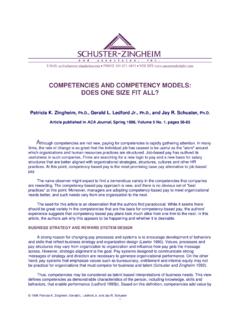Transcription of Louise Boyd Cadwell and the Reggio-Inspired …
1 Louise Boyd Cadwell and the Reggio-Inspired approach to education By Meghan Mulqueen Educators, psychologists, and researchers from all over the world acknowledge that the reggio Emilia approach is the most exceptional example of high quality early education in the world. Given the complexity of the approach , it is difficult to explain it briefly. To understand it better, I interviewed Louise Boyd Cadwell , an educator inspired by the reggio approach . From 1991-1992 Louise lived in the city of reggio Emilia, Italy, where she worked as an intern in two of its internationally acclaimed, municipally funded preschools. She returned to St. Louis, Missouri in 1992, where a 3-year Danforth Foundation grant was awarded to ten schools, both public and private, from the city and county, to study the reggio approach . Louise was hired as the lead consultant for this grant funded work and was based at The College School, where she continued to work until 2008.
2 Louise told me that "the reggio educators approach to school is centered on what is most important in life. The reggio Emilia schools for young children are organized to nurture and foster our highest potential as human beings. In my experience, this is the foundation that the reggio Emilia approach is based on." In her book Bringing Learning to Life: The reggio approach to Early Childhood education , Louise describes the key elements of the reggio Emilia approach : The Child as the Protagonist: All children have preparedness, potential, curiosity, and interest in constructing their learning. The Child as the Collaborator: There is an emphasis on working in small groups, which is based on the idea that we form ourselves through our interaction with peers, adults, things in the world, and symbols. The Child as the Communicator: This approach fosters children's intellectual development through a systematic focus on symbolic representation, including words, movement, drawing, painting, building, sculpture, shadow play, collage, dramatic play, and music.
3 The Environment as a Third Teacher: The design and use of the space encourages encounters, communication, and relationships. The Teacher as Partner, Nurturer and Guide: To know how to plan and proceed with their work, teachers listen and observe the children closely. Teachers ask questions, discover children's ideas, hypotheses, and theories and provide occasions for discovery and learning. The Teacher as the Researcher: Teachers work in pairs and engage in continuous discussion and interpretation of their work and the work of the children with all other staff. The Documentation as Communication: Teachers' commentary on the purposes of study and the children's learning process, transcriptions of children's verbal language, photographs of their activity, and representations of their thinking in many media are composed in carefully designed panels or books to present the process of learning in the schools.
4 Parents as Partners: Parent Participation is considered essential and takes many forms. The ideas, and skills that the families bring to the school as well as the exchange of ideas between parents and teachers, favor the development of a new way of education . Organization as foundational: Intricate and complex organization appears at every level and within every context in the municipal schools of reggio Emilia. It serves a larger purpose. It is not neat and tidy. It reflects the complexity and the order of the Universe. In our interview, Louise described what she feels makes the reggio Emilia approach so extraordinary. "One of the main benefits in the classroom is that most of the children develop a high level of skills in many of the 100 languages, which refers to the many ways in which children acquire knowledge. This means that they become confident in their own voice, and their ability to describe, wonder, and offer their ideas on how they see the world.
5 Also, they see themselves as active participants in learning, discovering, and creating as a part of a group. There is a sense of participation, almost like participatory democracy, that they are experiencing at a very young age. Their connection with the natural world is nurtured and developed in this approach so that they have a strong sense of place in terms of where they live and the community that they belong to." Although there are many benefits to working with the reggio Emilia approach , they do not come without challenges. Louise has experienced these challenges directly because as a teacher, she worked alongside others to reconstruct and reshape the way that early childhood education has often been viewed in the United States. "It takes energy courage and many extra hours to commit to rethinking what a classroom is and is for.
6 For example, with the reggio approach , the intention is to build a beautiful, home-like environment that is regularly refreshed with the children and parents so that the children understand the richness and importance of the environment as their learning home, the importance and respect for the materials, and of the care for all of it. If you look at the images of the environment in schools that are really working on this, they are very different then the average school. They are full of green plants, pillows and rugs and spaces large and small that are clean and aesthetically organized. Additional challenges that Louise experienced with bringing reggio to life in the classroom were related to the organization of the children into small groups. This often entails working with the ideas and thoughts of the children in a way that enables the teacher to follow along and observe in close detail.
7 It is also a challenge for the teachers and staff to find time to meet, organize, discuss, and present their captured and recorded experiences to their peers because this is not part of the normal school day. The final challenge that Louise described was that of parent involvement, "The challenge is that you want to involve the parents and link them and their opinions in so that they feel heard. Each parent has his or her own role to play and they are all very important to the community." For those schools and educators who are interested in adapting the reggio approach into their schools or starting a reggio Emilia inspired school, Louise suggests connecting with the North American reggio Emilia Alliance (NAREA), as well as subscribing to Innovations, a quarterly newsletter. Additionally, there are conferences and workshops in many places in North America and also in reggio Emilia, which are listed on the NAREA website Another way to learn about the approach and to research opportunities for learning and publications, is to visit the official reggio Children site, "There are many places and ways to start, Louise told me.
8 Start by asking open-ended questions to children and taking notes on what they say or organize an area of the classroom with materials and work with children to take care of them. Take pictures of interesting things going on around the classroom and have a discussion with children about them. Embrace the idea that school is life and that you want to create wonderful experiences that are remembered and grow and develop over time. Instead of viewing children from where you think they should be developmentally, seek to discover the children at the level that they are actually at. It is important to know the materials that you are working with, along with the multiple languages of learning, because there are so many ways to uncover and express ideas." In order to assist more schools in realizing their dreams, Louise along with her husband have launched a consulting company called Cadwell Collaborative: Sustainability education and School Design.
9 She said that it is a pioneer consulting group that provides school leaders and teacher leaders with the tools, ideas, and skills for curricular innovation in pre-K through grade 12 education . We offer resources, workshops, and consulting services in support of systemic change." Louise believes that the reggio approach has much to offer the growing field of sustainability education which includes place based education , learning from multiple perspectives in many ways, and understanding our interdependence with natural systems. The reggio approach has much to offer the world of education no matter the field or the age that we are. It is centered on identifying and developing the uniqueness and strengths of each child, each person and all of our capacities to collaborate, invent and create the world that we want to live in together.
